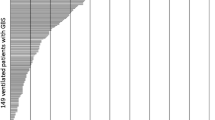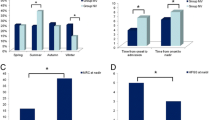Abstract
Background
Up to one fifth of patients with Guillain–Barré syndrome (GBS) require mechanical ventilation (MV). The Erasmus GBS Respiratory Insufficiency Score (EGRIS) is a clinical predictive model developed in Europe to predict MV requirements among patients with GBS. However, there are significant differences between the Latin American and European population, especially in the distribution of GBS subtypes. Therefore, determining if the EGRIS is able to predict MV in a Latin American population is of clinical significance.
Methods
We retrospectively analyzed clinical and laboratory data of 177 patients with GBS in three Peruvian hospitals. We performed a multivariate logistic regression of the factors making up the EGRIS. Finally, we evaluated the EGRIS discrimination through a receiver operating characteristic curve and determined its calibration through a calibration curve and a Hosmer–Lemeshow test, a test used to determine the goodness of fit.
Results
We found that 14.1% of our patients required MV. One predictive factor of a patient’s need for early MV was the number of days between the onset of motor symptoms and hospitalization. The Medical Research Council sum score did not alter the likelihood of early MV. Bulbar weakness increased the likelihood without showing statistical significance. In contrast, facial weakness was a protective factor of it. The EGRIS was significantly higher in patients who required early MV than in those who did not (P = 0.018). It showed an area under the curve (AUC) of 0.63, with an insignificant Hosmer–Lemeshow test result.
Conclusions
Although the EGRIS was higher in patients who required early MV than in those who did not, it only showed a moderate discrimination capacity (AUC = 0.63). Facial weakness, an item of the EGRIS, was not found to be a predictive factor in our population. We suggest assessing whether these findings are due to subtype predominance and whether a modified version of the EGRIS could improve performance.

Similar content being viewed by others
Change history
20 July 2021
A Correction to this paper has been published: https://doi.org/10.1007/s12028-021-01293-2
References
Landry O. Note sur la paralysie ascendante aigue. Gaz Hebd Med Paris. 1859;6(472–474):486–8.
Guillain G, Barré J-A, Strohl A. Sur un syndrome de radiculonevrite avec hyperalbuminose due liquide cephalo-rachidien sans reaction cellulaire. Remarque sur les caracteres clinique et graphiques des reflezes tendinuex. Bull Soc Med Hop Paris. 1916;40:1462–70.
Bogliun G, Beghi E, Italian GBS Registry Study Group. Incidence and clinical features of acute inflammatory polyradiculoneuropathy in Lombardy, Italy, 1996. Acta Neurol Scand. 2004;110(2):100–6.
Govoni V, Granieri E. Epidemiology of the Guillain–Barré syndrome. Curr Opin Neurol. 2001;14(5):605–13.
Hahn AF. The challenge of respiratory dysfunction in Guillain–Barré syndrome. Arch Neurol. 2001;58(6):871–2.
Sharshar T, Chevret S, Bourdain F, Raphael J-C. French cooperative group on plasma exchange in Guillain–Barré syndrome. Early predictors of mechanical ventilation in Guillain–Barre syndrome. Crit Care Med. 2003;31(1):278–83.
Netto AB, Taly AB, Kulkarni GB, Rao UG, Rao S. Mortality in mechanically ventilated patients of Guillain Barré syndrome. Ann Indian Acad Neurol. 2011;14(4):262–6.
Rees JH, Thompson RD, Smeeton NC, Hughes RA. Epidemiological study of Guillain–Barré syndrome in south east England. J Neurol Neurosurg Psychiatry. 1998;64(1):74–7.
Wijdicks EFM, Henderson RD, McClelland RL. Emergency intubation for respiratory failure in Guillain–Barré syndrome. Arch Neurol. 2003;60(7):947–8.
Orlikowski D, Sharshar T, Porcher R, Annane D, Raphael JC, Clair B. Prognosis and risk factors of early onset pneumonia in ventilated patients with Guillain–Barré syndrome. Intensive Care Med. 2006;32(12):1962–9.
Hernández-Torruco J, Canul-Reich J, Frausto-Solís J, Méndex-Castillo JJ. Predictores de falla respiratoria y de la necesidad de ventilación mecánica en el síndrome de Guillain–Barré: una revisión de la literatura. Rev Mex Neurocienc. 2013;14(5):272–80.
Lawn ND, Fletcher DD, Henderson RD, Wolter TD, Wijdicks EF. Anticipating mechanical ventilation in Guillain–Barré syndrome. Arch Neurol. 2001;58(6):893–8.
Toamad U, Kongkamol C, Setthawatcharawanich S, Limapichat K, Phabphal K, Sathirapanya P. Clinical presentations as predictors of prolonged mechanical ventilation in Guillain–Barré syndrome in an institution with limited medical resources. Singapore Med J. 2015;56(10):558–61.
Wu X, Li C, Zhang B, Shen D, Li T, Liu K, et al. Predictors for mechanical ventilation and short-term prognosis in patients with Guillain–Barré syndrome. Crit Care. 2015;19(1):310.
Walgaard C, Lingsma HF, Ruts L, Drenthen J, van Koningsveld R, Garssen MJP, et al. Prediction of respiratory insufficiency in Guillain–Barré syndrome. Ann Neurol. 2010;67(6):781–7.
Zúñiga-González EA, Rodríguez-de la Cruz A, Millán-Padilla J. Subtipos electrofisiológicos del síndrome de Guillain–Barré en adultos mexicanos. Rev Med Inst Mex Seguro Soc. 2007;45(5):463–8.
Kuwabara S, Yuki N. Axonal Guillain-Barré syndrome: concepts and controversies. Lancet Neurol. 2013;12(12):1180–8.
Hughes RAC, Cornblath DR. Guillain–Barré syndrome. Lancet. 2005;366(9497):1653–66.
van Doorn PA, Ruts L, Jacobs BC. Clinical features, pathogenesis, and treatment of Guillain–Barré syndrome. Lancet Neurol. 2008;7(10):939–50.
dos Santos T, Rodriguez A, Almiron M, Sanhueza A, Ramon P, de Oliveira WK, et al. Zika virus and the Guillain–Barré syndrome—case series from seven countries. N Engl J Med. 2016;375(16):1598–601.
van den Berg B, Walgaard C, Drenthen J, Fokke C, Jacobs BC, van Doorn PA. Guillain–Barré syndrome: pathogenesis, diagnosis, treatment and prognosis. Nat Rev Neurol. 2014;10(8):469–82.
Asbury A, Arnason B, Karp H, McFarlin D. Criteria for diagnosis of Guillain–Barré syndrome. Ann Neurol. 1978;3(6):565–6.
Asbury AK, Cornblath DR. Assessment of current diagnostic criteria for Guillain–Barré syndrome. Ann Neurol. 1990;27(Suppl 1):S21–4.
Hadden RD, Cornblath DR, Hughes RA, Zielasek J, Hartung HP, Toyka KV, Plasma Exchange/Sandoglobulin Guillain-Barré Syndrome Trial Group, et al. Electrophysiological classification of Guillain–Barré syndrome: clinical associations and outcome. Ann Neurol. 1998;44(5):780–8.
Alva-Diaz C, Mori N, Pacheco-Barrios K, Velásquez-Rimachi V, Rivera-Torrejon O, Huerta-Rosario CA, et al. Guía de práctica clínica para el diagnóstico y tratamiento del paciente con síndrome de Guillain-Barré. Neurolgía Argentina. 2020;12(1):36–48.
Doets AY, Verboon C, van den Berg B, Harbo T, Cornblath DR, Willison HJ, IGOS Consortium, et al. Regional variation of Guillain-Barré syndrome. Brain. 2018;141(10):2866–77.
Mcgrogan A, Madle GC, Seaman HE, de Vries CS. The epidemiology of Guillain–Barré syndrome worldwide. A systematic literature review. Neuroepidemiology. 2009;32(2):150–63.
Capasso A, Ompad DC, Vieira DL, Wilder-Smith A, Tozan Y. Incidence of Guillain–Barré syndrome (GBS) in Latin America and the Caribbean before and during the 2015–2016 Zika virus epidemic: a systematic review and meta-analysis. PLoS Negl Trop Dis. 2019;13(8):e0007622.
Munayco CV, SotoCabezas MG, Reyes MF, Arica Gutiérrez JA, Napanga SO. [Epidemiology of Guillain–Barré syndrome in Peru]. Rev Peru Med Exp Salud Publica. 2019;36(1):10–6 (Spanish).
Ballón-Manrique B, Campos-Ramos N. Características clínicas y paraclínicas del síndrome de Guillain–Barré en el Hospital Regional Lambayeque. Rev Neuropsiquiatr. 2017;80(1):22–6.
Castañeda ML, Deza BL. Respuesta clínica al tratamiento con recambio plasmático en pacientes con síndrome de Guillain Barré. Hospital Guillermo Almenara Irigoyen ESSALUD 1995–1998. Rev Neuropsiquiatr. 2000;63(3–4):182–94.
Vásquez C, César J. Costos de tratamiento de pacientes con síndrome Guillain Barré en el servicio de neurología y unidad de cuidados intensivos del Hospital Nacional Edgardo Rebagliati Martins. Trujillo, Peru: Universidad Nacional de Trujillo; 2009.
Durand MC, Porcher R, Orlikowski D, Aboab J, Devaux C, Clair B, et al. Clinical and electrophysiological predictors of respiratory failure in Guillain–Barré syndrome: a prospective study. Lancet Neurol. 2006;5(12):1021–8.
Yamagishi Y, Suzuki H, Sonoo M, Kuwabara S, Yokota T, Nomura K, et al. Markers for Guillain–Barré syndrome with poor prognosis: a multi-center study. J Peripher Nerv Syst. 2017;22(4):433–9.
Tan C-Y, Razali SNO, Goh K-J, Shahrizaila N. The utility of Guillain–Barré syndrome prognostic models in Malaysian patients. J Peripher Nerv Syst. 2019;24(2):168–73.
Chung HK. Comparison between EGRIS and outcome of Guillain–Barré syndrome: retrospective study in one center [abstract]. Neurology. 2012;78(Suppl 1):P06.144.
Dourado ME, Félix RH, da Silva WKA, Queiroz JW, Jeronimo SMB. Clinical characteristics of Guillain–Barré syndrome in a tropical country: a Brazilian experience. Acta Neurol Scand. 2012;125(1):47–53.
Tatsumoto M, Misawa S, Kokubun N, Sekiguchi Y, Hirata K, Kuwabara S, et al. Delayed facial weakness in Guillain–Barré and Miller Fisher syndromes. Muscle Nerve. 2015;51(6):811–4.
Sekiguchi Y, Misawa S, Suichi T, Amiono H, Shibuya K, Kuwabara S. Facial nerve palsy and disease severity in Guillain–Barre syndrome. J Neurol Sci. 2017;381(Suppl):1073.
Acknowledgments
We thank Dr. Victor Velasquez, from Red de Eficacia Clínica y Sanitaria, for his review of the manuscript.
Funding
This study was self-funded.
Author information
Authors and Affiliations
Contributions
Authorship requirements have been met, and all authors approved the final manuscript. Contributions are as follows: MM: Conceptualization, Methodology, Analysis, Data collection, Data curation, Writing - Original Draft, Writing - Review & Editing, Supervision; ARC: Methodology, Data collection, Data curation, Writing - Original Draft, Writing - Review & Editing, Supervision; AMN, KR, LM, DBP: Data collection, Data curation, Writing - Original Draft; JMS, GCK: Writing - Review & Editing, Supervision; CAD: Methodology, Analysis, Writing - Review & Editing, Supervision.
Corresponding author
Ethics declarations
Conflict of interest
The authors declare no conflicts of interest.
Ethical approval/informed consent
The institutional review boards of the participating institutions approved this research protocol. For this type of study, formal consent was not required.
Additional information
Publisher's Note
Springer Nature remains neutral with regard to jurisdictional claims in published maps and institutional affiliations.
The original article has been updated to correct affiliations of corresponding author Carlos Alva Diaz.
Rights and permissions
About this article
Cite this article
Malaga, M., Rodriguez-Calienes, A., Marquez-Nakamatsu, A. et al. Predicting Mechanical Ventilation Using the EGRIS in Guillain–Barré Syndrome in a Latin American Country. Neurocrit Care 35, 775–782 (2021). https://doi.org/10.1007/s12028-021-01218-z
Received:
Accepted:
Published:
Issue Date:
DOI: https://doi.org/10.1007/s12028-021-01218-z




